The Kurds in Khorasan, North-east of Iran

The Khorasani Kurdish region is found within the current north-eastern borders of Iran and the southern borders of Turkmenistan, in the northern sector of what has historically been known as the Province of Khorasan.
Geographical coordinates of Khorasani Kurdish region is between N(36.5–38.3)˚ and E(56-61)˚. The area of Kurdish inhabited region in Khorasan estimates about 64144 square kilometres.
This Kurdish region is located on the Revand Heights, two parallel ridges running in a south-easterly direction from the Caspian Sea to the borders of Afghanistan where they join the Parapamisus Mountains.
The Revand forms a bridge between the high Alborz Mountains to the west and the Hindu-Kush massif to the east. The Revand may be considered the eastern third of the Alborz.
On this part of Alborz as the southern parallel ridge; the Aladaq mountains range is in South of Bojnurd, Saluk mountain (the highest summit; 2670 meters) is as western part of Aladaq, Shahjahan mountain (the highest summit; 3032 meters) is as the eastern part of Aladaq located in south of Shirvan and Quchan, and the Binalud mountain (the highest summit; 3211 meters) is in south of Quchan-Mashhad valley and or north of Neishabur.
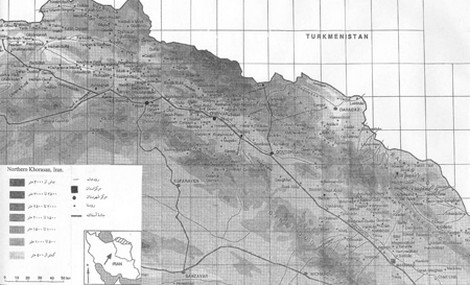
Khorasani Kurdish region; mountains, cities, main villages and rivers origin.
The northern parallel ridge is Coppet-dagh which starts from eastern bank of Caspian Sea. The continuation of Coppet-dagh in north of Khorasan is called Hazarmasjed mountains range. Kuhe-Zeinadanlou is the eastern part of Hazarmasjed (the highest summit called Gullil; 3200 meters) which rests in north of Shirvan.
The two parallel ridges of the Revand act as ramparts to a long fertile valley within which the seven main cities; Ashkhaneh, Bojnurd, Shirvan, Qochan, Daregaz and doroongar, Radkan and Chenaran lie approximately equidistant from each other.
The Atrak River runs almost the entire length of the valley, from the southeast to the northwest, before emptying into the Caspian Sea. The smaller Kashf River drains the south-eastern quarter of the valley, running the exact opposite course of the Atrak before disappearing into the sands of the Kara Kum desert of Turkmenistan in Central Asia.
Thick Caspian forests cover the western part of the Khorasani Kurdish region in border with Golistan Province, becoming grassland toward the east. The northern slopes facing the parched Kara Kum desert support some grass but are primarily open stands of tamarisk trees and bushes.
The summers generally vary from pleasant in the mountainous areas to hot in low land areas. Winters, however, are brutal: the cold Siberian air mass descends on the region like a frigid dome, causing temperatures to drop as low as minus 20˚C (- 20 ˚C).
Heavy furs (especially regional lamb coats and hats); heavy woollen clothing is thus necessities in this area especially in the winter season. In the past as in the present, many of these warm items were produced both for local use and for export; they were marketed in the local bazzars (markets) of Qochan, Shirvan, and Bojnurd as well as in the great exporting market routes.
The important city of Mashhad, long the capital of Khorasan Province, is on the immediate eastern fringes of the Khorasani Kurdish region. To the west lies the city of Minoodasht, in the Province of Golistan in the way to Tehran.
Thus the Khorasani Kurdish region has easy access to extensive markets, both for exporting its own good and for importing any technology or product it needed. There are also many other ancient towns and cities dotting the Revand Heights and its piedmont. The modern Turkmen Capital of Ashkhabad (Ashgabat), for example, is located on the northern slopes of the Revand, with its southern suburbs and city of Firuzeh as the Kurdish inhabitant area.
The main trunk of the old Silk Road crossed the southern slopes of the Revand, passing through Mashhad on its way to Sabzivar, Tehran and beyond. A secondary trunk line ran northwest from Mashhad through the major Kurdish cities of Qochan, Shirvan, and Bojnurd. This northern route passed through the heartland of the Khorasani Kurdish region, but was always less important than the southern route due to predation by Turkmen raiders from the thirteen century onward.
Significant commerce nonetheless took place along the secondary line: the Kurds sold passing merchants such as commodities as dried foodstuff (raisins, almonds, walnuts, apricots, peaches etc.), dairy products, meat, cereals, raw wool, finished woollens, cotton goods, rugs, kilims, and various other textiles.
The Turko-Mongolian nomadic influx, which began as a trickle in the sixth century, turned into a destructive flood with the arrival of Genghiz-Khan’s Mongol armies in the thirteenth century. As a result, when the present Kurdish population began to arrive in the early seventeenth century, this most fertile land in south-western Asia was largely depopulated, its formerly prosperous urban / agricultural base destroyed by the Mongols.
The major influx of Kurds occurred in the early seventeenth century when they were deported in masse from Northern part of Kurdistan in Turkey, by the Safavid Kings of Persia, who forced them into exile to northern Khorasan and beyond. These arrivals did not cease until well into the eighteenth century.
The primary Kurdish tribal confederacies in the region were the same as the original fief divisions under the Safavids. The most important was the Za’faranlu, headed by the house of Chemishgezek (Chamishgazak name in the Khorasani Kurdish region was changed to Za’afaranlu confederacy, about 1760 AD), whose last capital at Quchan was the largest city and market in the Khorasani Kurdish region, but not any more on today.
Among the Kurdish autonomous princely houses of 16th century, the Chamishgezek of Dersim, Malatiya, Elazig, Adiyaman toward Bohtan in Kurdistan of Turkey were a strong aristocratic Kurdish confederacy. After the Treaty of Zohab (between the Ottoman Empire which controlled Iraq, and Persia), 17 May 1639 AD, a relative calm descended upon Kurdistan and its autonomous principalities, to be broken relatively, but very harshly from 1722 AD onward.
Autonomous Kurdish principality of Chamishkazak or autonomous tribal chieftains of Chamishgazak in Turkey were completely finished after WWI. The traditional power structure was replaced by newly built state government, in line of Kurdish integration.
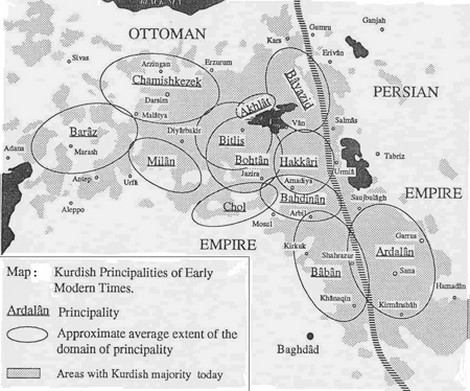
Kurdish tribal aristocratic confederacies; Dr Mehrdad Izady, 1992, The Kurds; a concise handbook.
The Za’faranlu Kurdish confederacy had always controlled the largest area and the borders in north-west of Iran, and contained the most member tribes, clans, and households.
Rarely the Za’faranlu lost the political and military leadership of the Khorasani Kurds. They also distinguished themselves through their military service to the Persian court, defending Persia’s north-eastern imperial borders against incursions by Central Asiatic powers. It was the Za’faranlu generals and their Kurdish contingency that played a major role in the conquest of Mughal-India for the Persian monarch Nader Shah in 1738 AD.
The Kawanlu tribe (their headquarters was Radkan) became a constituent part (a very large one) of the Za’faranlu confederacy. In 1835 the Za’faranlu territory stretched from the western environs of Mashhad to halfway between the towns of Shirvan and Bojnurd.
The Shadlu tribe were second in importance; their Capital was at Bojnurd (the former city of Buzanyurd / Buzanjurd).
The Qarachorlu tribe held the westernmost territory of the Khorasani Kurdish region, and were the most exposed to the Turkmen raiders. The town of Samalqan served as their headquarters.
There were also several smaller confederacies at the time, including the Jelali, whose territory was the northern hill country facing the great Kara Kum desert in Central Asia. The headquarters of Jelai tribe was Firoozeh.
The Kurds who arrived in Khorasan were largely from the parts of Northern Kurdistan in South-eastern Turkey. And even today, about 4 centuries later, they speak various dialects of the North Kormanji language which still predominates among the Kurds (in Turkey). The costumes and customs of Khorasani Kurds resemble those of the Kurds in Turkey more closely than those of the other Kurds. The women wear high-heeled shoes and knee-high skirts, worn in layers and fitted with white aprons or coloured waistcoats.
There can be little doubt that this was the fashion that Kurds wore in Anatolia four hundred years ago, as no other groups in Khorasan wear anything remotely resembling this costume. The tenacity with which the Khorasani Kurds have maintained their antique language, customs, culture and costumes strongly suggests an equal tenacity in preserving their national Kurdish and Iranian traditions.
Kurdish tribes forced to move to Khorasan region / North-east of Iran during Safavid Dynasty about 1598 AD (or 1610 AD according to some texts).
By the beginning of the 16th century, the Shiite Safavid (Iranian) Empire had emerged as a rival to the Ottoman Empire. The Kurds found themselves in the middle of the territories claimed by the Sunni Turkic Ottomans and the Shiite Persian Safavids. The two empires fought at the Battle of Chaldiran in 1514 AD, where the Ottomans defeated the Safavid Shah. The result of the battle established a boundary between the two empires that split the Kurds between Turkic and Persian empires.
Since the 16th Century, contiguous Kurdistan has been augmented by two large, detached enclaves of (mainly deported) Kurds. These two enclaves are Central-Anatolian enclave and North-Khorasan enclave.
Since World War I, Kurdistan has been divided among five sovereign states, with the largest portions of Kurdistan territory in Turkey (%44) followed by Iran (%30), Iraq (%18), Syria (%6) and the former Soviet Union (%2). These states have subdivided Kurdistan into a myriad of administrative units and provinces (Khorasani kurdish enclave is divided among two provinces of Northern Khorasan and Razavi Khorasan, although the kurds resisted against this unfaire division but were oppressed and jailed especially students and young generations who were arested and beaten harshly after a peacefull demonstration in this regards in Quchan, 2002 AD).
The Central-Anatolian enclave includes the area around the towns of Yunak, Haymana and Jahanbeyli / Jahanbegli, South of the Turkish capital of Ankara. It extends into the mountainous districts of North-Central Anatolia, where it is bounded by the towns of Tokat, Yozgat, polatli, Chorum and Amasya in the Yisilirmaq river basion. The fast expanding North-Central Anatolian segment of the enclave now has more Kurds than the older segment in Central Anatolian.
Of the two large detached enclaves of the Kurds, the one in Khorasan owes its existence to the deportations from Northern Kurdistan. Almost all the Kurdish population in Khorasan therefore speaks in Kurmanji, but centuries of exposure to the Shiite community of Iran and the proximity to the Shiite holy city of Mashhad have rendered the community a mixture of Sunni and Shiite Muslims, with a peppering of Alewi (Alevi) adherents. It has had a far less tumultuous history in the past few Centuries than the Northern Kurdistan most of its inhabitants left behind. The Khorasani Kurdish community preserves a tradition now lost to its original home, as their deportations coincided with the beginning of a sustained cataclysmic military ravaging of Northern Kurdistan by Persian and Ottoman Empires.
About more than 60,000 Kurdish families and tribes forced to move to Khorasan region / North-east of Iran during Safavian Dynasty 1610 AD, and the reason for that was purely political. They were sent to Khorasan in order to defend the province from attacks by Uzbek and Kazakhs warriors, and also to weaken the Kurds in Kurdistan which their democratic demands were not in line of ruling tyrant.
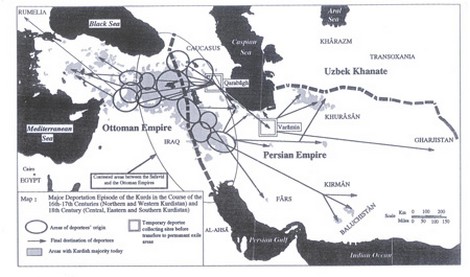
Kurdish dislocation: Dr Mehrdad Izady, The Kurds; a concise handbook, 1992.
Kurds who are considered to be very determined and jingoistic people by nature did the job and pushed the warriors back to where they belong to and consequently the politic of Shah abbas Safavi had worked to perfection by using Kurds in order to preserve the integrity of the country and his ruling at the time. Therefore, Khorasani Kurds have rescued Iran from foreign occupation and continued to do so till today.
Currently about more than 1.5 million Kurds are living in Khorasan (60% in villages, 35% in Cities and 5% as Nomadic migrants people / koçberî), the most majority of them talks in Kurmanji dialect of Kurdish language.
In Northern Khorasan (with total population of 850.000); the population of Kurds is about 70% of the Province (about 595.000), Turks (who are the remnant of Uzbeks and Kazaks invaders of Iran, 16 Centaury) about 18% of the Province (about 153.000), Fars about 7% of the Province (about 60.000), and Turkmen is about 5% of the Province (about 45.000) who are in Jargalan rural district / border with Turkmenistan. About 600.000 Kurds live in the west and Northwest of the Razavi Khorasan Province.
About 13 to 15% of Mashhad population (Capital of Razavi Province, with the population of about 3.000.000) is Kurds, which in figure becomes about 400.000 as estimates. The total population of Kurds in Khorasan estimates slightly more than 1.5 million.
The main Kurdish inhabited cities in Khorasan are: Quchan, Shirvan, Esfarayen, Bojnurd (Bozenkurd), Kalat, Lain, Daregaz & dorungar, Faroj, Bajgiran, Chenaran, Ashkhane, Mane-u-Similqan, Joveyn, Raz, Radkan, Sabzivar (rural district in northern part), Sarakhs, also there is a large number of Kurds who live in Mashhad.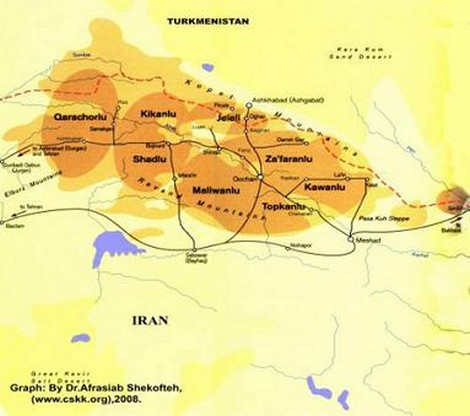
Khorasani Kurdish main tribes and their inhabited regions and cities.
It is needless to say that the lack of state investment has left the area in destitution, undeveloped with no prosperity; about 23% of Kurds in Khorasan are completely illiterate especially nomadic immigrants.
Khorasani Kurds are not allowed to be educated in their own mother language, and the regional ruling officialdom is not from khorasani Kurds. They are not allowed to have any organised Kurdish political, cultural, educational and civil centres or forums to improve and modernise their culture, language and social affairs which is their logical basic civil rights, in Iran. Khorasani Kurds does not have any radio or TV station in their language. Kurdish leaders, intellectuals and writers are prosecuted, insulted, oppressed and jailed.
Kurdish tribes in Khorasan are mostly settled in regional cities and villages, although there still are some pastoralist migrating nomads. Those who are settled in the villages work in agricultural (sugar beets, cotton, cereals, vegetables, by-product such as hay etc.), gardening (fruits, grapes, nut trees etc.) and livestock economy. Those who live in the cities involved in public and private sectors, and in market trading society. The average rate of state employment in Khorasani Kurdish region estimates about 15% respectively.
Pastoralist herding especially in mountains and the steep slops is a way of traditional economy yet. The most important livestock of Kurdish tribes are sheep and to a lesser extent goats and cattle. Animal products include; meat, milk, wool, leather and dairy products such as; cheeses, yogurt, curds, buttermilk and butter. Kurdish handmade rugs, kelims, carpets and other textiles are still produced in relatively large quantities.
There is not that traditional tribal power structure (see later) anymore by having a modern state governing and economy system in Iran. The most majority of Khorasani Kurdish intellectuals want to preserve their culture, language and traditions within a plural society by a modern ruling style based on UN human rights framework in the state of Iran.
Nowadays, as industrialised age with the high information technology, transportations and communications, there is not that tribes’ chieftains left in Kurdish region of Khorasan and by this; the collection of revenue and manpower in aim of governing the tribes, remains too weak. Individualism and the values of democracy and pluralism are getting stronger amongst young generations day by day, although there is no that state investment in the region. Infrastructurally, khorasani Kurdish region is the least developed, the overall level of modern improvements remains below the national averages, in comparison to other provinces such as Tehran and Esfahan.
Khorasani Kurdish region has two sites of oil reserves as natural resources; one is in Quchan and the other one in Raz. There is a Gas field in Khangiran, Sarakhs. These oil reserves are not in use yet as there is no oil refinement there, although it might be useful for the local petrochemical factory in Bojnurd.
Women are allowed some freedom in compare to the other people for example Baluch or Arabs. Kurdish nomadic women are semi-unveiled, except in cities and large towns that veils are frequently being forced on Kurdish women. Nomadic Kurdish women and even those of in villages are not in that cautious degree to hide themselves but most of the hard manual labour and children caring falls upon them. Nowadays, in the urban areas, Khorasani Kurdish women are active in education, cultural and civil affaires.
The most majority of khorasani Kurds are Shia Muslim. The subject of religion is rarely used by the Kurds to create literature and ceremonies except by the state local rulers. Khorasani Kurds are not a religious people in general, which is not in line of the state rulers. Khorasani Kurds are brave and famous in hospitality and kindness especially about outsiders’ guests.
Kurdish people in the region mostly suffers from zoonoses diseases such as; Brucellosis, Tuberculosis, Salmonellosis and Parasitic infestation. Rheumatic problems in adults and malnutrition in children are common. Health services are available in a limited form in local clinics and health centres especially in main villages in the routes of immigrant tribes between their seasonal encampments.
The role of tribes as preventive health care is seldom. The traditional medications such as using especial regional plants as herbal medications are rarely used, especially in the summer or winter camps. The Avian flu and Anthrax has seen in the region, for instance the Anthrax was seen in the village of Cherri suburban of Faruj, 1996, that was covered by local health services.
New year festival “ Newroz ” on 21st March is respected between Khorasani Kurds, as it is identical to state and national festivals, in despite of ideological religious rulers reluctance. Marriages and funerals are important events. Gifts are exchanged between the wedding families, and after marring ceremonies the couple receive more presents for their new lives.
The area around Lake Van in Turkey, as Kurdish inhabited regions for thousands of years has historically been one of political instability as a frontier region between major local political entities. After the Turkic invasions of the 11th century AD there was a brief unity of Anatolia and Iran under Seljuk, during which there was the junction of the major east-west and north-south trade routes. Following of the break up of the Seljuk Empire the region became a part of the Akkoyonlu Empire (Safavid), itself a nomad dynasty.
Subsequently it formed an unstable buffer zone between the Ottoman Empire and successive Persian dynasties, becoming progressively depopulated during the conflicts of the Safavid period. Although migratory Kurdish tribes were undoubtedly present in earlier times, the unstable conditions of the period following 1,600 AD brought about the strengthening of tribal affiliations and an expansion of Nomadic activity. The historical origins of the Khorasani Kurds are around Lake Van in south-east Turkey on today.
The last chief of Za’afaranlu was Shahpur Negahban died in 1960. After the land reform of 1962 AD, the most of the chiefs of settled clans severed relations with their tribes. In 1979, at the outbreak of the Islamic revolution, their only role was that of mediator between families, or between nomads and the administration. They were consultants rather than chiefs of a clan or tribe.
Nowadays the immigrant Kurds in the North of Khorasan spend their summer in the mountain pastures of Hezarmasjed, Binalud and Shahjahan and their winter in the plains of Sarakhs, Pasakuh and Daregaz and in the Turkmen steppe as far east as Chat. They have spread right across the north of Khorasan from east to west and even occupy part of eastern Turkmen steppe.
Historically, areas like Sarakhs, Pasakuh and Daregaz had been thought of as Kurdish winter quarters ever since the reign of Shah Abbas I. Marava-tapah (72 mile, North-west of Bojnurd, former Bozenkurd) on the southern bank of the Atrak River is also the winter quarters of the Kurds. Some time there has been conflicts between the Guglan clan of Turkmen and the nomadic Kurds of Bojnurd. The Kurdish claim to have been using the pasturelands in the Turkmen steppe for the last 100 years is a reliable one.
The seasonal immigration route from Shirvan and Quchan (summer camps) to Maraveh-tapeh (winter camp) is about 400 km, and from Quchan (summer camp) to Sarakhs (winter camp) is about 200 km.
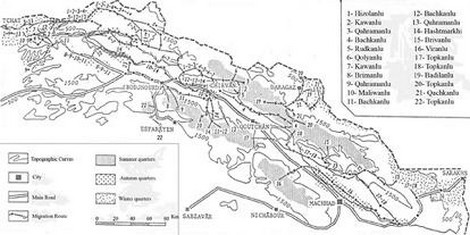
Kurdish migratory tribes: seasonal encampments’ routes and destination in Khorasan, Iran.
Those clans of Kurds who spent the winter in the grazing around Daregaz usually have their summer pastures in the mountains of Hazarmasjed, and those who spent the winter in the Turkmen-sahra region, in the summer migrate to the mountains of Shahjahan.
The summer encampments are divided as follows: about 42% in the mountains of Hazarmasjed, about 48% in the mountains of Shahjahan and 10% in the pastures of Binalud. This has been interpreted as demonstrating that Shahjahan is more attractive as a summer camping ground than Hazarmasjed, the earliest centre for the Kurds in northern Khorasan.
The great majority of those spending their summers in Hazarmasjed belong to the semi-nomadic Kurdish tribes and their winter quarters are more widely dispersed than the summer quarters.
In winter, the encampments of the nomads in the north of Khorasan are located in five different areas; Turkmen Sahra 44.5% , The Sarakhs region 44% , The Daregaz area 5.5%, whilst Sabzivar and Esfarayen only attract 4.5%, Maneh (district beside the Atrak River, which is in halfway between Shahjahan and Turkmen Sahra) about 1.5%.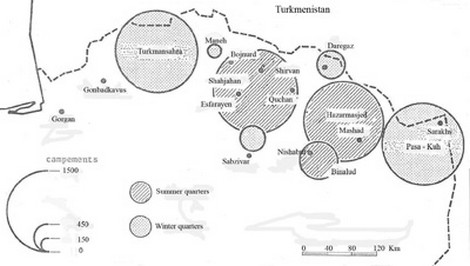
Seasonal encampments of immigrant Kurds in Khorasan, Iran.
There is no any census that records the ethnic origins of the inhabitants of Khorasan. Therefore, it is impossible to estimate the exact population of immigrant Kurds present in the total population. For the variety reasons the national census in Iran is not trusted as a precise and democratic one, although it is not covering the issues of minorities. During the Shah’s regime the extent of the nomadic population and nomadism in general, was concealed as far as possible. The number of Kurdish nomads in Khorasan estimate at around 120,000.
Khorasani Kurdish traditional social structure and networking power’s ranks were organised according to the following hierarchy:
Social Structure >>> Network Power
1- Greater tribe (Confederacy) >>> ill-khan (Mir)
2- Tribe (ill) >>> ill-Beg (Khan)
3- Clan (Tayfeh) >>> Beg (Kad-khoda)
4- Sect (Toper) >>> Rih-gewir (senior person)
5- Camp group (Obe / Bine) >>> Sar-obe (Camp chief)
6- Family (unit / tent /quwin) >>> Sare-male (family head)
The only major Kurdish confederacy in Khorasan was Chamishgazak confederacy which its name was changed to Za’afaranlu confederacy, about 1760 AD (made up of about 32 tribes; 8 major plus 24 small tribes). Usually about 4 to 8 unit make an Obe depends on their livestock size.
Ill-khan as head of Kurdish confederacy had a strong political power and was in relating to central government. Ill-khan also was responsible for protecting the State borders from warriors. Confederacy was a combine of some tribes as wider political organization; an affinity was recognized with adjacent tribes such as the Kawanlu, Topkanlu, Kikanlu, Jalai, Maliwanlu and Qarachorlu as Za’afaranlu confederacy. These political power rankings and principle were destroyed in Reza-shah time, 1920 AD, wishing to control, reorganize or disband nomad tribes.
Tribal names are generally composed of an origin followed by the suffix " Li " or " Lu " which implies " of " or " belonging to ". Thus a tribe may acquire its name by a founding father’s name, for instance; the name Kavanlu (Kowanli / Kawanlu) comes after Kava / Kawe, which is the name of Kava the blacksmith (621 BC) who is the creator of Newroz and its fire festival celebration, 21st March on every years until today.
Alternatively some characteristic or nick name, for instance such as Pahlavanlu (very strong or athlete) might be rife into the tribal name structure simply reflects the fact that tribal and village designations are frequently interchangeable.
Nowadays, the tribes in Khorasan are not hierarchically organised, unlike in former one that each tribe had an organised structure with a head chief. Khorasani Kurdish tribes and clans are listed with their locations as following. Remarks in parentheses include alternative tribal name. The language of them is Kurdish dialect of Kormanji.
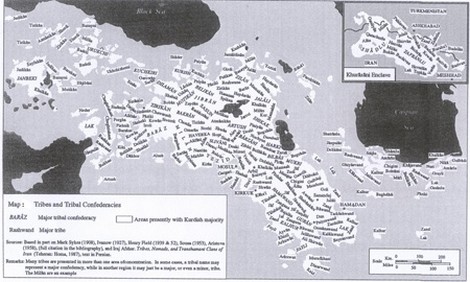
Kurdish tribes; Dr Mehrdad Izady, The Kurds; a concise handbook, 1992.
Kurdish tribes in Khorasan:
1- Artekanlu; a clan from Amarlu tribe who lives in artiyan village closed to Mohamad-Abad of Daregaz and villages in rural district of Marusk suburbs of Neyshabur.
2- Alanlu; A clan from Shadlu tribe who lives in villages in countryside of Bojnurd, such as; Garivan, Nystanah, Firuzeh, Mahestan, and also some other villages in Maneh va Samalqan and Jajarm.
3- Amiranlu (Sheykhamiranlu); a clan from Greater tribe of Za’afaranlu who lives in Shirvan and North of Esfarayen.
4- Ulashlu; A clan from Sivkanlu (sivirkanlu) tribe who lives in villages such as; Ghale-safa, Ghosh-ghale, Titkanlu, and also in Shirvan, Quchan and Mashhad.
5- Bachvanlu; A clan from Qachkanlu tribe, subdivision of Kavanlu tribe, who lives in villages such as; Palkan, Jolfa and Borj-ghale (Toranlo) in countryside of Daregaz. Some of Qachkanlu tribe live in rural district of Dolat-khane, in villages such as; Fath-abad and Qachkanlo in countryside of Quchan.
6- Bachiyanlu / Bachvanlu; A clan from Greater tribe of Za’afaranlu who lives in Ashkhaneh, rural district of Dolat-khaneh suburbs of Quchan, villages of Baba-cheshmeh suburbs of Esfarayen.
7- Badelanlu (Bahadoranlu); this clan lives in villages such as; Alaghe-jonban, Kalateh-gol, Marghzar suburbs of Quchan. Some of them live in Nokhandan of Daregaz and Golmakan. The last leader of this clan was Taj-mohamad-khan.
8- Bagiarlu; A clan from Amarlu tribe who live in the village of Amarlo in countryside of Neyshabur.
9- Balkanlu (Palkanlu); This clan lives in village of Jeristan in countryside of Shirvan, Palikanlo Sofla & Oliya in Nokhandan rural district of Daregaz.
10- Badranlu; A clan from Greater tribe of Za’afaranlu who lives in villages such as; Badiranlo and Heydar-abad in countryside of Bojnurd.
11- Barivanlu (Birivanlu / Barimanlu); a clan from Greater tribe of Za’afaranlu who travel between Daregaz and Sarakhs (winter camps) and Binalud (summer camps). Some of them setteled in Mashhad, Kalat and Daregaz.
12- Boqanlu; A clan from Shadlu tribe who lives in village of Ali-abad in countryside of Bojnurd.
13- Bovanlu; A sect from Sivikanlu clan of Kikanlu tribe, who lives in villages such as; Ghale-safa, Ghosh-ghale, Titkanlo, and cities such as Shirvan, Quchan and Mashhad.
14- Burzanlu (Barezanlu); a clan from Greater tribe of Za’afaranlu who lives in villages such as; Burzanlo and Heydar-abad in countryside of Bojnurd.
15- Buzanlu; aclan from Greater tribe of Za’afaranlu who lives in village of Khesht in countryside of Kalat.
16- Bicharanlu (Bakran / Shamali / shamlu); a clan from Kikanlu tribe who lives in rural district of jiristan in countryside of Shirvan, villages such as; Honameh, Ghale-hasan, Gadogan, Gholanlu, Ghale-naqdo, Ghale-dolu, Kalateh-bali.
17- Pazuki; A clan from za’afaranlu tribe who lives in villages such as; Kalteh-Habashi, Mohamad-abad, Shams-abad, Char-borj, Kalate-badilu in the countryside of Golmakan, which is closed to Mashhad.
18- Payi; A clan from Amarlu tribe who lives in rural district of Marusk in countryside of Neyshabur.
19- Pahlavanlu; this clan is from Greater Za’afaranlu tribe who lives in villages such as Dor-badam, Emam-qoli an Bardar in countryside of Bajgiran, and some of them live in Shirvan and Bojnurd.
20- Piranlu; A clan from Greater Za’afaranlu tribe who lives in rural district of Mezerj in countryside of Quchan.
21- Pirvadanlu; A sect from Bicharanlu clan of za’afaranlu tribe who lives in village of Pirvadanlo.
22- Tarsanlu (Torsanlu); a clan from Kavanlu tribe who lives in village of Arghoon-shah in countryside of Kalat. Some of them setteled in Chenaran and Mashhad.
23- Tupkanlu (Topkanlu); this tribe lives in Quchan, Shirvan, Esfarayen, Mashhad and in Northern region of Neyshabur. Some of them travel between summer camps (Akhlamad, Kuh-Klidar, in south-eastern of Quchan) and winter camps (Sarakhs and Mozduran). The sects of this tribes are; Karikanlo, Kalmishi, Farhad-khani, Latifi, Torabi, Shir-ghazi, Agha-mohamad-khani, Samkani, Zeynali, and Samimi.
24- Turanlu; A clan from za’afaranlu tribe who livez in villages of Turanlo and Borj-ghale suburbs of Nokhandan. Some of them travel between summer camps (Kismar) and winter camps (Haji).
25- Titkanlu; A sect from Badilu clan who lives in village of Titkan, North-western of Quchan.
26- Jalali; A tribe who lives in villages such as Firuzeh, Gholjogh suburbs of Shirvan, and village of Kuran suburbs of Faruj. Some of them live in Bojnurd and Shirvan. The most majority of them live in the cities of Ashghabad and Firuzeh in Tukmenistan State / just over the border. The clans of Jalali tribe are; Kopniklu, Kordikanlu, Kargarlu, Kurkanlu, Kuranlu, Kusanlu (Kuse), Guran.
27- Jozanlu (Jawzanlu); this clan live in village of Jawzan suburbs of Quchan.
28- Chapanlu; A clan from Shadlu tribe who lives in villages in suburbs of Bojnurd, such as; Garivan, Nystanah, Firuzeh, Mahestan, and also some other villages in Maneh va Samalqan.
29- Chakhmaqlu; A clan from Shadlu tribe who lives in villages in suburbs of Bojnurd, such as; Garivan, Nystanah, Firuzeh, Mahestan, and also some other villages in Maneh va Samalqan.
30- Chakanelu; this clan lives in village of Chakaneh and Sarvelayat as suburbs of Neyshabur. Some live in Nokhandan, suburbs of Daregaz.
31- Hamzikanlu(Hazoanlu); A clan from Kikanlu tribe who live in villages such as; Hamzekanlu bala, Hamzekanlu payin suburbs of Quchan, Hamzekan suburbs of Bojnurd, rest of them live in village in countryside of Golmakan. Hazo is related to a place in Turkey as their origin.
32- Khakhiyanlu; this clan lives in village of Khakhiyan suburbs of Nokhandan, Daregaz.
33- Kheder (Xidir); a clan from Kikanlu who live village of Khedir suburbs of Shirvan.
34- Khosravanlu; A clan from Pahlavanlu tribe who live in villages such as Partan suburbs of Esfarayen, Khosraviye suburbs of Faruj.
35- Khallanlu; A sect from Khalikanlu clan of Kavanlu tribe who live in villages such as; Khalikanlu in rural district of Jaffar-abad suburbs of Quchan, khalano suburbs of Daregaz.
36- Khomartash (Xurtash); a sect from Za’afaranlu tribe who live in village of Khomartash in North of Quchan (6 km).
37- Davanlu; a clan from za’afaranlu tribe who live in Jajarm of Bojnurd.
38- Dudanlu; this clan live in village of Dudanlo in the valley of Shakar-ab suburbs of Daregaz.
39- Duleshanlu; a sect from Bachvanlu clan of Kavanlu tribe who live in village of Duleshanlu suburbs of Nokhandan, Daregaz.
40- Diranlu; A clan from Shadlu tribe who lives in villages in suburbs of Bojnurd, such as; Garivan, Nystanah, Firuzeh, Mahestan, and also some other villages in Maneh va Samalqan and Jajarm.
41- Dirqanlu; A clan from Shadlu tribe who lives in villages in suburbs of Bojnurd, such as; Garivan, Nystanah, Firuzeh, Mahestan.
42- Rashvanlu; a tribe from Greater tribe of Za’afaranlu who live in village of Halvacheshmeh, Ghopoz, Kakoli, Bagh, Amir-khan, Gholak-bala, Gholak-payin, Dadakhan, Jangah, Ghale-mohamadali in rural district of Ghoshkhaneh suburbs of Shirvan, rural district of Mayvan suburbs of Faruj.
43- Rutkanlu; a clan from Za’afaranlu who live in villages such as; Shogha, Tavarik, Joshaghan, Mohamad-abad, Chapan and Hasar suburbs of Quchan. Some of them travel between summer camps (Maraveh-tapeh) and Hazarmasjed, Kismar.
44- Zardikanlu; a clan of za’afaranlu tribe who live in Quchan and Bojnurd, and some live in village of Ghopranlo suburbs of Bojnurd.
45- Zangilanlu; a clan from Kavanlu tribe who live in villages such as; Shamsi-khan, Zangilanlo rural district of Lotf-abad. Some of them live in Radkan.
46- Zangane; these are from Zangane tribe of Kermanshah, who live in villages such as; Niyaz-abad, Ghasem-abad, Asad-abad, Shahrak-Ebrahimi suburbs of Khaf in Southern Khorasan. Some of them live in village of Hasar, rural district of Lotf-abad, Nokhandan.
47- Zurtanlu; a clan from Sivkanlu tribe who live in villages such as; Zurtanlu suburbs of Shirvan, Ghale-safa, Ghosh-ghale, Titkanlu suburbs of Faruj. Some live in village of Zurtanlu rural district of Kapkan,suburbs of Chavushlu.
48- Zeydanlu (Zidanlu); a clan from greater tribe of Za’afaranlu who live in villages such as; zeydanlu in North-eastern of Quchan, Zinadanlu and Lotf-abad in the valley of Dorungar, suburbs of Daregaz, Layin of Kalat.
49- Zinadanlu; a clan from Bicharanlu tribe who live rural district of Jeristan suburbs of Shiravan, village of Zinadanlu suburbs of Nokhandan, Daregaz.
50- Zinkanlu; a clan from Greater tribe of Za’afaranlu who live in village of Zinikan in rural district of Cheri suburbs of Faruj.
51- Salanquch; a clan from greater tribe of Za’afaranlu who live in village of salanquch suburbs of Quchan.
52- Savidanlu; a clan from greater tribe of Za’afaranlu who live in villages such as; Razmaqan and Sevaldi suburbs of Shirvan.
53- Sivirkanlu (Sifkanlu); this tribe is subdivision of Kikanlu tribe who live in villages such as; Oqaz, Zeynalbeg, Ghizilqan, Bovanlo, Charborj and Shokranlo, Chapanlo suburbs of Shirvan, Emam-qoli, Dor-badam and Sharkanlu suburbs of Quchan. Some of them live in Shirvan, Quchan and Mashhad. They origin come from Sivek region (near Diyarbakir) in Turkey.
54- Sil-Seporanlu; a clan from greater tribe of Za’afaranlu who live in village of sil-seporan suburbs of Shirvan.
55- Sinanlu; a clan from Kikanlu tribe who live in villages such as; Ghale-Hasan, Ghale-Naghdo suburbs of Shirvan, and some live in Esfarayen.
56- Sivadanlu; a clan from Za’afaranlu tribe who live in villages such as; Tanasivan and Sevaldi suburbs of Shirvan.
57- Shadkanlu; a clan from Farmanlu tribe who travel between summer camps (Kuh-Armutli, Shajahan) and winter camps (Maraveh-tapeh).
58- Shadlu; an important tribe who live in Bojnurd, Jajarm and Maneh & Samalqan and the most majority of villages in suburbs of these cities. The clans of Shadlu tribe are; Chakhmanlu, Diranlu, Boghanlu, Amarlu, Tatikanlu, Dirqanlu, Qlichanlu, Heybatzanlu, Chapanlu, Kaqanlu, Qobranlu, Alanlu, Izanlu, Godanlu, Joyanlu, Matiranlu, Qerebashlu and Garivanlu.
59- Shahraki; a clan from Za’afaranlu tribe who live in village of Sharak suburbs of Quchan.
60- Sharanlu; a clan from Za’afaranlu tribe who live in village of Kalate Shah-mohamad suburbs of Quchan, village of Shahranlo in rural district of Cheri suburbs of Faruj. Some of them travel between Summer camps (Maraveh-tape) and winter camps ( Hezarmasjed).
61- Shahrkanlu (sharanlu); a clan from Kikanlu tribe who live in rural district of Jeristan suburbs of Shirvan.
62- Shahkanlu; a clan who live in villages of Doghayi and Shahkanlu suburbs of Quchan.
63- Sheykhvanlu (Sheykhkanlu); a clan who live in Quchan, Radkan, Chenaran, and also in Daregaz in villages such as; Sheykhvanlu Olya and Sheykhvanlu Sofla. Some of them live in Khoy in west of Urmiya, West of Iran.
64- Shirzanlu; a clan who live in village of shirzan suburbs of Quchan.
65- Safakanlu; a clan from sivikanlu who live in villages such as; Ghale-safa, Ghosh-ghale and Titkan suburbs of Quchan.
66- Sufiyanlu; a clan from greater tribe of Za’afaranlu who live in villages such as Mohamad-taghi-bag and Doost-mohamad-bag suburbs of Nokhandan, Yeka-bagh, Karim-abad, Layin-kohne, Kohlab and Robatt suburbs of Kalat. Some live in Mashhad.
67- Azlu; a clan from Amarlu tribe who live in Marusk region, suburbs of Neyshabur.
68- Amarlu; a tribe who live in about 72 villages of Marusk region, suburbs of Neyshabur. Some live in Quchan, and also Gilan province. Some still travel between summer camps (Hezarmasjed, Amarat) and winter camps (Maraveh-tapeh).
69- Ghamparanlu; a clan from Za’afaranlu tribe who live in villages such as; Karivan, Nystaneh, Firuzeh, Mahestan, Ghale-alavirdikhan and Ghale-Mohamadkhan suburbs of Bojnurd.
70- Ghachkanlu; a clan from Kavanlu tribe who live in villages such as; Fath-abad, Dizavand, Jafar-abad-sharghi and Qachkanlu suburbs of Quchan, village of Shamsi-khan in rural district of Bachvanlu suburbs of Daregaz. Some of the travel between summer camps (Hazarmasjed, Kani-sar camp) and winter camps (Daregaz, Sarakhs and some to Maraveh-tapeh).
71- Ghasemanlu; a clan from Za’afaranlu tribe who live in village of Ghasemanlo in Shahjahan Mountain (between the city of Esfarayen and Shirvan).
72- Qarabashlu; a clan from Shadlu tribe who lives in the villages in suburbs of Bojnurd, such as; Garivan, Nystanah, Firuzeh, Mahestan.
73- Qarachorlu; a tribe from Greater tribe of Za’afaranlu (former chamishgezek confederacy), who lives in villages in Bojnurd and its suburbs, and urban district of Maneh & Samalqan, Ghuri-Maydan and Garmeh. Some of them are settled in Daregaz in the villages of Palkan Olya and Palkan Sofla.
74- Qaraghashlu; a clan who lives in villages of Alast and Alask in rural district of Safi-abad in countryside of Esfarayen.
75- Qaramanlu (Ghahramanlu); a tribe from Greater tribe of Za’afaranlu (former chamishgazak confederacy), who lives in villages of Kawaki and Mayvan, cities of Faruj, shirvan and Quchan. Some of them still travel between the summer camps (Kuh-Armutli) and winter camps (Maraveh tapeh).
76- Qelichanlu; a clan from Shadlu tribe who lives in villages in suburbs of Bojnurd, such as; Garivan, Nystanah, Firuzeh, Mahestan.
77- Qubranlu; a clan from Shadlu tribe who lives in villages in suburbs of Bojnurd, such as; Garivan, Nystanah, Firuzeh, Mahestan.
78- Qurochanlu; a clan who lives in village of Hassan-kadkhoda in suburbs of Daregaz.
79- Qurkhanlu; a clan from Za’afaranlu tribe who lives in village of Hassan-kadkhoda in suburbs of Daregaz.
80- Kaltamanlu; a clan from Greater tribe of Za’afaranlu (former Chamishgazak confederacy), who lives in village of Kaltamanlo in rural district of Jeristan in countryside of Shirvan.
81- Kaqanlu; a clan from Shadlu tribe who lives in villages in suburbs of Bojnurd, such as; Garivan, Nystanah, Firuzeh, Mahestan and Qubranlo.
82- Kalajlu (khalajlu); a clan from Kikanlu tribe who lives in rural district of Jeristan, Shirvan.
83- Kanimashkan; a clan as subdivision of Sifkanlu tribe from Greater tribe of Za’afaranlu, who lives in village of Oqaz suburb
84- Kavanlu (Keyvanlu / Kawanlu / Kowanlu / Kawi); a major tribe from za’afaranlu greater tribe / Za’afaranlu tribal aristocratic confederacy (traced from south and eastern part of former Chamishgazak principality, Turkey), who lives in the cities of Radkan, Chenaran, Quchan, Shirvan, Daregaz and Kalat and La’in, and their villages for instance; Shamsi-khan, Zinglanlu, Chavoshlu, Mohamad-abad (suburbs of Daregaz), Spiyan, Kahu, and Takab (Tako). Some of them still travel between summer camps (Hezarmasjed, Esfejir camp) and winter camps (Heji, Maraveh-tapeh and Dashte-taqar). Subdivision of this tribe is; Torsanlu, Govareshkanlu, Khalikanlu, Buzanlu, Pazuki, Miyanlu, Khalanlu. Their last leaders were Misir-Xan Shekofteh and Haji Karam Molawi.
85- Kahanlu; a clan fron Kavanlu tribe who lives in village of Kahu suburbs of Daregaz.
86- Kopniklu (Kokhbiniklu); a clan from Jalali tribe, subdivision of Greater tribe of Za’afaranlu (former chamishgazak confederacy) who lives in villages of Kuran, Esfejir, Titkanlu, Zidanlu, Shikhkanlu and Dolat-khaneh suburbs of Shirvan and Faruj.
87- Kordikanlu; a clan from Jalai tribe, subdivision of greater tribe of Za’afaranlu, who lives in village of Mezerj, North of Quchan.
88- Kuranlu; a clan from Jalai tribe, subdivision of greater tribe of Za’afaranlu, who lives in village of Kuran suburbs of Faruj.
89- Kurkanlu; a clan from Jalali tribe, subdivision of greater tribe of Za’afaranlu, who lives in village of Kurkanlo in rural district of Jeristan suburbs of Shirvan.
90- Kuse (Kusanlu); a clan from Jalali tribe, who lives in village of Kuse in rural district of Jeristan suburbs of Shirvan.
91- Komkilanlu; a clan from Sifkanlu tribe, subdivision of Za’afaranlu tribe, who lives in village of Chapanlo suburbs of Shirvan, city of Bajgiran, Villages of Ghosh-ghale, Titkanlo suburbs of Quchan, Village of Rahman-gholi rural district of Nokhandan.
92- Kikanlu (Keykanlu); a major tribe from greater tribe of Za’afaranlu (former chamishgazak confederacy), who lives in Maneh and Samalqan, and in some villages in the border line of Shirvan, some lives in village of Inche-kikanlo suburbs of Quchan.
93- Garivanlu; a clan from Shadlu tribe who lives in villages in suburbs of Bojnurd such as; Garivan, Neystaneh, Firuzeh and Mahestan.
94- Ganjalu; a clan who lives in Abiverd suburbs of Daregaz.
95- Gadukanlu; a clan from Bicharanlu tribe who lives in villages of Gaduganlo suburbs of Shirvan, and the other village with the same name in suburbs of Daregaz.
96- Ganjbeylu; a clan from Za’afaranlu tribe who lives in the village of Safar-ghale suburbs of Daregaz.
97- Guran; a clan from Jalali tribe who lives in villages of Gholjugh, Firuzeh suburbs of Shirvan, and some of them lives in Quchan and Bojnurd.
98- Guganlu; a clan from Za’afaranlu who lives in village of Gogan suburbs of Quchan (North-east).
99- Guliyanlu; a tribe from greater tribe of Za’afaranlu who travels between summer camps (Aladaq, near village of Shoghan) and winter camps (Maraveh-tapeh, near Aytamir and Aq-ghamish).
100- Gawshanlu (Hawshanlu / Gawareshkanlu); a clan from Kavanlu tribe who lives in villages of Khesht suburbs of Kalat, Duleshanlu suburbs of Daregaz.
101- Gilanlu; a clan from Za’afaranlu tribe who lives in village of Gilan, rural district of Jafarabad, suburbs of Quchan.
102- Mamiyanlu (Miyanlu); a clan from Kavanlu tribe who live in village Mamadanlu suburbs of Daregaz.
103- Metranlu; a clan from Shadlu tribe who lives in villages of Garivan, Neystaneh, Firuzeh and Mahestan suburbs of Bojnurd.
104- Mardkanlu; a clan from Za’afaranlu who live in village of Mardkanlo in rural district of Cheri suburbs of Faruj.
105- Malevanlu; a clan from Za’afaranlu who lives in village of Malevanlo in rural district of Jeristan suburbs of Shirvan.
106- Milanlu (Milli); a tribe who lives in villages such as; Milan in rural district of Jeristan suburbs of Shirvan, and in suburbs of Esfarayen in villages such as; Dolat-abad, Ghasem-abad, Partan, Abbas-abad, Noshirvan, Ardaghan and Bidvaz.
107- Mazdeganlu (Muzhdakan); a tribe who like Amarlu tribe lives in rural district of Marusk, suburbs of Neyshabur. Mazhdakanlu tribe are closely mixed with Amarlu tribe.
108- Namanlu; a clan from Za’afaranlu who lives in rural district of Jeristan, suburbs of Shirvan.
109- Navakhlu (Nawixlu); a clan from Veranlu tribe who lives in village of Navakh, North-east of Quchan.
110- Veranlu; a tribe who lives in villages such as; Shafie, Kheyr-abad, Ebrahim-abad suburbs of Quchan, and some of them lives in Radkan and Chenaran. Some of them live in villages such as: Garivan, Firuzeh, Ghale-alahvirdi, Ali-abad suburbs of Bojnurd. Some of them travel between summer camps (Binalud, Kuh-Klidar, A
___________
Source: http://www.cskk.org/en/modules.php?name=News&file=article&sid=19
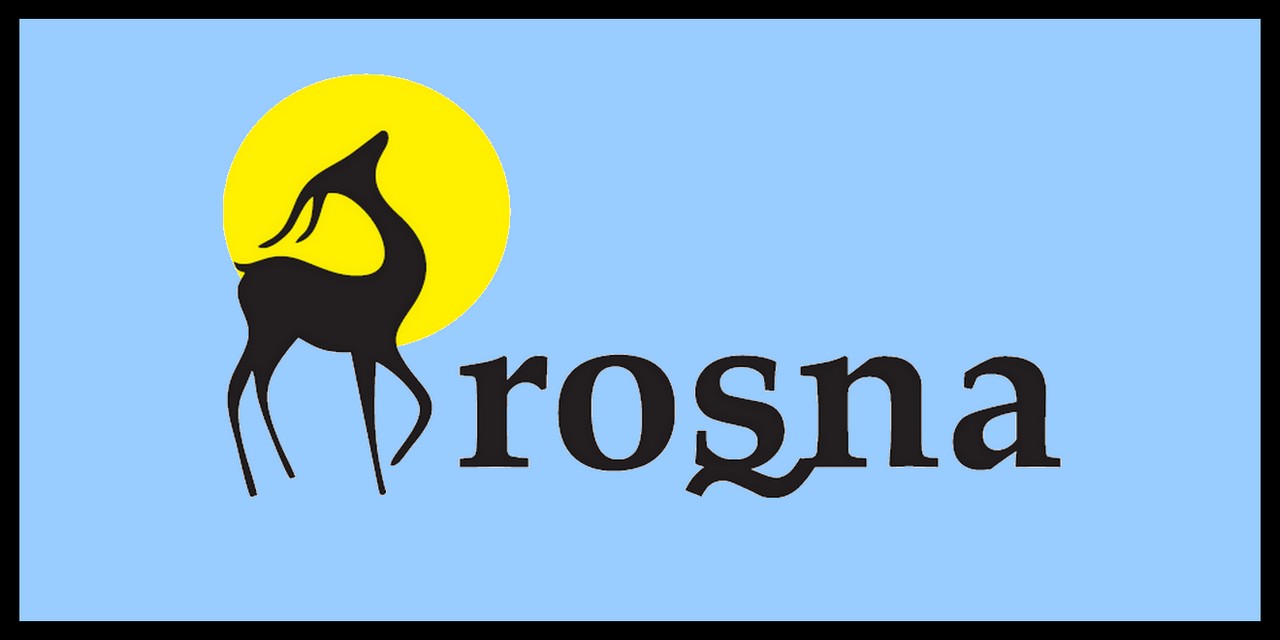
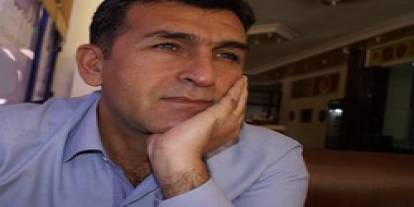
Türkçe karakter kullanılmayan ve büyük harflerle yazılmış yorumlar onaylanmamaktadır.